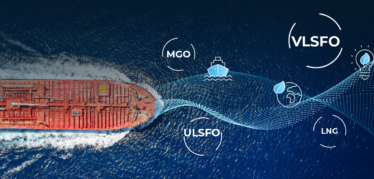Less than three months in, the EU ETS is quickly making an impact in the maritime world. While the extent and value of that impact is yet to be determined, organizations around the globe are actively assessing the processes and programs they need to comply. It begs the question; will the US or other regions follow suit? And if so, what learnings could we apply?
Recently, I participated in a panel at CMA Shipping week in Connecticut, where we discussed this very topic. Darren Shelton, Director at Moran Shipping Agencies, moderated the discussion, which also included Sean Pribyl, Partner at Holland & Knight LLP, and Ronny Waage, Global Sales Director at ZERO44.
We covered important learnings from the EU ETS rollout, the need for contract standardization, what the US might be thinking, and more. Read on for my full recap:
Key lessons from the EU ETS rollout
If there’s one thing we’ve learned, it is not to underestimate the complexity of maritime. Maritime is just as, if not more, complicated than energy and manufacturing industries, which paved the way for ETS over the past decade. It is an industry with complex contracts, layers of ownership, and interdependent stakeholders. Unsurprisingly, this complexity led to some significant challenges in the EU ETS rollout. As Ronny Waage from ZERO44 pointed out, “It is clear that [the European Commission] did not laisse much with the industry in advance of implementing the system, in understanding how shipping actually works, how you trade, who’s involved, who is ultimately responsible for what.” For example, up until one month before launch it wasn’t clear which industry party would be responsible for surrendering allowances. Without the ability to plan for that layer of responsibility, it made it very difficult for organizations to adequately prepare.
Which aligns closely to the next key learning: timely communication is critical. For a successful rollout of any industry-wide change, key stakeholders need to have a clear understanding of processes, accountabilities, and timeframes. While we learned a month before rollout that ship owners would ultimately be responsible for surrendering allowances, we continue to learn new details well after the rollout, such as who can register for a maritime operator holding account and what member state a company will need to register in, which was still to be defined as of February of this year. While I believe that the European Commission made every effort to communicate this detail quickly, it likely took more time than expected to align on these various layers of responsibility.
And third, to affect real change, enforcement is necessary. This is something that the EU ETS rollout definitely got right. While other sustainability and decarbonization initiatives have historically offered a “carrot” (a stamp of approval and the benefits of a greener future), the EU ETS has also extended a “stick” (steep fines that no organization wants on their P&L). The tangible threat of forfeiting revenue is likely why the EU ETS is driving real action across maritime. While it has taken some time to get organized, organizations across the industry are now working diligently to implement new technology and processes to comply with the regulation.
“Consensus confusion” and the need for contract standardization
With so many different organizational structures, contract types, vessel types, voyage variables, etc. across maritime, it is near impossible to establish EU ETS industry-wide standards. Therefore, the strategies for building EU ETS into contracts, especially for multi-leg voyages, are extremely varied. We even see a lack of alignment within organizations, with different approaches from one desk to another. Many companies are beginning to create their own clauses and standards, especially larger charterers who might choose to give ETS allowances rather than higher freight rates, for example.
This lack of standardization across contracts makes it challenging for organizations to track risk, responsibility, accounting, and more. If you’re interested in more on this topic, we covered it in depth in our recent webinar, Overcoming EU ETS Contract Challenges, featuring panelists from BIMCO, Trafigura, and TORM.
How likely is a US ETS?
Sean Pribyl, Partner at Holland & Knight LLP, has first-hand insight into these discussions for the US. He explains, “There is a big difference between what is a mandate, and what is a goal. And [the United States] is still living in the goal lane right now. And to get to those mandates, they need to be developed smartly so that there are no unintended consequences.” He explained that, ultimately, the US could choose to be aggressive with decarbonization initiatives, or they could take a “wait and see” approach, which is the most likely scenario.
Just as maritime is complex, so are governments like the US. The layering of various governing agencies from state to federal levels creates additional challenges. To adopt a system such as the ETS, we would need clarity on who would administer it, manage the market trading, and more. The US might be more likely to wait until a global scheme is on the table.
The ultimate goal
It is important to remember that the goal of ETS is to reduce emissions. And while the EU ETS has been around for a long time, it’s only now being applied to the maritime industry. There are a lot of organizations out there, both internationally and within the US or other countries, that have very strong internal protocols around sustainable initiatives. I’m hopeful that the learnings from these protocols and initial sets of regulations will help pave the way. While the EU ETS rollout for maritime hasn’t been perfect, it’s a major step in the right direction.



 Giftson Eliyesar
Giftson Eliyesar
 Hongbeom Park
Hongbeom Park
 Oliver Kirkham
Oliver Kirkham